#Buddha Day Ceremony
Explore tagged Tumblr posts
Text
Character Design: Part 5
FEATHERS
Another detail I’d like to mention about his tattoo before moving on is that the peony tattoo was originally meant to be accompanied by leaves, but they changed this for the final design. Leaves make sense, they’re natural, but feathers?

Feathers alone seem to have no relevance in Japanese culture, but there are two relevant birds that have black plumage: cormorants and crows.
Cormorants are valued birds for their fish-hunting skills and were often trained to help fishermen. Therefore, they are a symbol of devotion and unceasing commitment to their master.
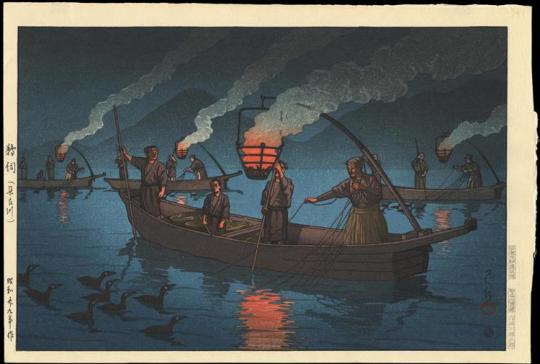
Crows are probably the first thing that comes to mind when we think of black feathers, and just like in other countries they can be associated with evil, but also with supernatural powers, and are considered messengers of the gods. It is commonly associated with fire and the sun, it is said that it was the only bird that can fly to the sun, and its feathers are black because they were marked by its rays.
They are often represented together with a white heron, like yin and yang, day and night, good and bad.
Within mythology we find Yatagarasu, a sacred crow that had three legs. Heaven, Earth and humanity. Yatagarasu is sent by a god (I think Amaterasu, but I’ve also read about Takami-musubi) to help humans, a symbol of guidance, of connection between the spiritual and physical world.

They were once associated with rebirth and rejuvenation, as they cleansed the land after a battle. Rebirth after a tragedy. It was believed they carried the souls of the deceased, similar to butterflies, to the next plane of existence. In art they often represent death, the passing of time. Apparently they’re also sparrows’ natural enemies.
In short, each element of this poisoned tattoo only seems to be mockery after mockery on Ryuuhou’s part, a representation of what he knows will happen. The similarity of the tribal to birds, the meaning of peonies, the seed syllable inside the bird on his arm, and now the feathers as an addition to Koujaku’s virtues or as a premonition of death and tragedy. Death and destruction are carved all over his body. (He’s terrified of it, and avoids it, but Sly seeks it)
HAIR
Now let’s move on to hair. Hair is a symbol of spiritual power in many cultures around the world. As we’ve seen before in the sutra it is associated with Buddha, and by extension it is also associated with Koujaku, who’s a hairstylist and dedicates his life to cutting and controlling hair.
In ancient Japan, hair was a gift from god, it has been identified as a special focus of spiritual power and personality. The longer the better, it’s like it remembers thoughts and emotions, our identity. For this reason there are various ways in which social status is tied to hair too. It’s also used to curse people. There is a hair kami at the Arashiyama Kamigami shrine if I’m not mistaken, and you can make an offering by cutting a lock of your hair. In Sumo, when a fighter retired, they would ceremonially cut it.
Hair has been used and incorporated into Buddha embroidery as a way of forging a link between the worshipper and the Buddha depicted. Locks of hair can be seen at the doors of the Izumo shrine, which specializes in marriage. There are also stories of women who let their hair down when they go to sleep and the hair turns into snakes, poisonous desire, repressed during the day. There are other folkloric practices and beliefs about women’s hair, for example ship captains carrying part of their wives’ or daughters’ hair on board as a protective talisman.
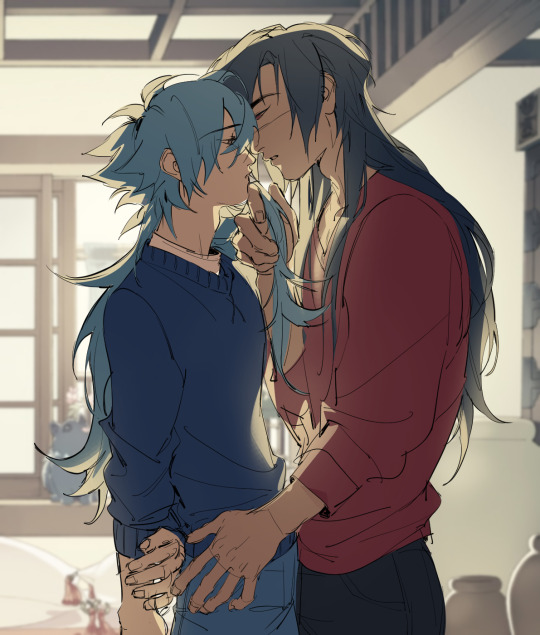
In some communities, it is believed that a shaman’s powers, which allow her to negotiate between the worlds of the living and the dead, were located in her long, loose hair, a sacred connection with the gods, the darker and the longer the better.
For Koujaku, Aoba’s hair is sacred, extremely valuable. He had wanted to cut it for years, we see how excited he is when he touches and kisses it, and when he is finally able to fulfill his dream he carefully keeps one of his locks wrapped in a piece of paper inside a paulownia wood box. For him, his hair is an amulet, it is good luck, it is extremely symbolic of who Aoba is (and who wouldn’t remember him as the dude with blue hair, one of the key features of his design, as well as the very peculiar characteristics that the developers gave it) and what he means to Koujaku.

The lock of Aoba’s hair is a direct connection to him, no matter how far away he is or how long it takes them to see each other again, he will always have this amulet with him. He is a devotee of Aoba, Koujaku adores him and loves him intensely, and it is not unusual to think that this devotion takes on an even religious aspect, as if Aoba was divine, a god.
In Tibetan Buddhism they paint Buddha’s hair blue.


Koujaku's hair is tied up like a miko's, with a cylinder or strap of white paper and red knot. They also use a miko styled paper for Aoba's hairstyle in an illustration and the figure.
Paulownia wood is associated with nobility, fertility, good fortune and happiness. Paulownia is a tree that was often planted when a girl was born. Wealthy families would plant up to three trees, and when the girl grew up and was time to get married, the family would cut down the tree and make a chest and other items out of the wood to give to her on her wedding day. The kimono was meant to be stored in good quality wood to preserve it, and this wood naturally repels insects. It’s also used for instruments.



Another detail about Koujaku’s hairstyle is that his hairpin looks like a shamisen.



Trying to protect his mother from his father and legal wife only caused her more pain, so instead he tried to do something else. She’s so happy about the gift, and the wishes of her son to help her fill her with joy, but she knows that’s impossible. He’s only a kid, so she just smiles, without being able to reply. Honestly, given that this was a gift he made to his mother to brighten her day, I wonder if it could be related to her tastes, especially considering that the most common are simple or with floral decoration. We don’t know almost anything about her, her name, appearance, what she liked to do or to dress like, what she taught Koujaku to raise him, etc…

So seeing this I wouldn’t be surprised if his mother actually played this instrument and maybe taught her son. The point is that this illustration exists.
A Tumblr user recently mentioned it on her post.

GOOD LUCK
Another piece of his design are these bracelets he wears on both hands. These bracelets are prayer beads, called Nenju or Juzu. Originally used in Buddhism to help with meditation by counting prayers, 108 beads are used representing the 108 earthly desires that one seeks to overcome in order to reach enlightenment, used to purify body and mind and express devotion to Buddha. They are used as protection as well. There are versions with fewer beads, 18, 27, 36 or 54, although there’s no fixed amount as many times it depends on the length and size of the beads, sometimes they carry a magatama. Women’s version usually has smaller beads and have more decorative colors, there are versions for children too. Beni’s necklace to me is just a kids version Koujaku bought for him to be honest…

Formal prayer beads also vary their appearance depending on the sect and it would be preferred that the person you marry belongs to the same sect. The tassels can also vary their shape. When these beads are damaged or can no longer serve their purpose, they are ritually burned on an altar where they are thanked for their service along with other amulets and get destroyed. Many people use them in funerals since most are held by Buddhists.

The ones that Koujaku wears in the shape of a bracelet are short, with two hanging tassels, the ones he’s using are 頭付房, I’m not sure how this translates but seems something like tassel with head/head tassel. Made to be more comfortable to carry anywhere, taking up less space or in a casual fashion. I like thinking he has formal Buddhist prayer beads kept somewhere for when he wants to pray for the people he knows.
The knot on his neck and the one in the decoration of his hair is a kiku knot, chrysanthemum knot, with two tassels hanging too. It’s also the type Shiroba/Sly uses in the bad ending. We’ve already seen what the chrysanthemum means. This knot is theorized to be a variation of a Buddhist knot, the endless knot, as a representation of Buddha’s infinite wisdom. In Tibetan Buddhism it symbolises Samsara, a never ending cycle. There are a few other interpretations.

Knots with tassels like this (総角房) would also be used in samurai helmets as a good luck charm, and it’s the type he has on his sword, not the chrysanthemum one.


We don’t really see or hear about Koujaku performing any religious practices during the story, except attending the festivals that everyone else goes to out of custom rather than a religious devotion. But I wouldn’t find it strange if he did it in the privacy of his home to try to attract luck in his life and try to separate himself from the beast, to be a good person and pray for his mother. After all, cultural and religious references are everywhere, and he himself wonders about the existence of souls, implying a much more spiritual understanding of life on his part.
Red is the first thing that catches your eye when you look at his design, and it’s a very important color in shintoism and is used in shrines everywhere, in clothes, buildings, torii gates, amulets, etc. It’s a color related to luck, the sacred, that coexists in balance with white. It’s love and passion, and it’s evil and blood. These dualities are present everywhere, both in his design and in his story.
72 notes
·
View notes
Text

Episode Eleven has a lot to unpack... including some cultural nuances that even I wasn't too knowledgeable about (so I had to ask my mom for clarification)

We're heading to Chao Fah Palace (คุ้มเจ้าฟ้า) in the province of Phrae (แพร่) for this episode... which is derivative of the old Lanna Kingdom and its culture. (We spoke a little bit about Lanna traditions when referencing the hairpins in episode five). Lanna territories are now part of modern-day Siam. In Lanna tradition, women were known as ช้างเท้าหลัง (pronounced 'chang tao lahng') which would literally translate into "the hind legs of the elephant". What it meant was that the direction of a woman's life and family were to be guided by the authority of a man, ช้างเท้าหน้า (pronounced 'chang tao nahr') "the front legs of the elephant". The woman must learn to accept her place. Lanna Buddhist tradition would preach that being born as a woman in this life meant you had not earned enough merit to be born a man, and to pray for better karma in the next lifetime. Ironically, before the rise of Buddhism, Lanna was one of the few territories to practice matrilineal succession... where lineage was passed on from mother to daughter.
Both of these beliefs were somewhat knit together for TLP's narrative in regards to Uangfah... which we'll talk about later.


ผ้าซิ่นตีนจก (pronounced 'pa sin tin jok') is a traditional skirt worn by women in Lanna. The skirts are known to have elaborate borders with strips of precious metals woven together, with spun gold or silver threads, by using a traditional loom. This technique emphasizes the beauty and value of the weaving, as well as the social status of the person wearing the skirt. The garment was generally reserved for high-ranking members of society.


Another practice steeped in Lanna tradition, is the art of making ตุง (pronounced 'toong'). In the northern dialect, this refers to a type of flag used in Lanna art and Buddhist ceremonies. The flags, adorned with various patterns and designs, are used to mark the boundaries of sacred sites as a symbol of the pathway toward enlightenment.


The series highlighted the Phra That Cho Hae Temple (พระธาตุช่อแฮ), which has rich history as a spiritual center and the most sacred Buddhism site in Phrae. Its highlight is the brass wrapped pagoda that stands 33 meters tall, which enshrines holy relics of Lord Buddha.

The Peacock Feather Dance (รำฟ้อนหางนกยูง - pronounced 'ram faan haang nohk-yuung') is a cultural piece of entertainment that sees dancers move in a circle and change positions in order to imitate the movements and courtship "dance" of a peacock. The dancers wear traditional northern costumes while holding peacock feathers. Known for its striking appearance, the peacock holds deep cultural and religious significance in Thailand. It is often associated with the ideas of beauty, royalty, prosperity, and spiritual awakening.



We are introduced to Uangfah's mother this episode. Princess Dararai holds the title of หม่อมเจ้าหญิง (mom-jao ying or M.C.) for being married to a descendant of the king. Princess Dararai wishing for her daughter to remain close to her after marriage has inklings of matrilineal customs, where the husband would typically come to live with the wife's family... and not the other way around.
The suitor Princess Dararai has chosen for her daughter to marry is Lord Muang-Rahm. Muang-Rahm holds the tilte of หม่อมราชวงศ์ (mom rat-cha-wong or M.R.) as a child of one "commoner" parent, but whose ancestry can be traced back to the king.

Uangfah has accepted the fact the she must submit to her mother's wishes and marry a man she does not care for (he's truly terrible... lesbi-honest). It's a bittersweet moment where we realize the realities of a woman who cannot openly pursue the love of another woman, given the views of society.
The proceeding conversation Uangfah has with Muang-Rahm is subtlety indicative of Lanna women who were in charge in their own relationships. Uangfah quietly inserts her authority over their future courtship by informing Muang-Rahm of her intentions to not wed straight away AND by addressing him by his nickname in front of Pia. Given his behavior, Muang-Rahm knows he cannot say anything untoward in order to save face... such a fun scene.


SHE KNOWS!!! The facial expressions 😂😂😂... you have to laugh
Anil and Pin have become more reckless the more comfortable they have become in their relationship... and that spells trouble ahead.
#the loyal pin#thai culture#anilpin#koda watches gl#talk thai to me#koda's royal records#WE'VE CAUGHT UP!!!#until tomorrow hehe#huge s/o to kru mae 🙏🏾🙏🏾🙏🏾#came in clutch
90 notes
·
View notes
Text
➠ Symbolism of Yuuji’s childhood memories in Chapter 265 and how it connects to his conversation with Sukuna:
I was rereading the latest chapter and ended up dwelling on how the order in which certain things appear along the path Yuuji and Sukuna are walking connects with the progression of their conversation and the outcome of it, so I want to point out a few of such details in case someone else finds it interesting.
First, I will start with Morning Glory (asagao, 朝顔, lit. morning face) Yuuji mistakes Ajisai for. Asagao was brought to Japan with the advent of Buddhism and came to represent Enlightenment. When one thinks of the flower, an old line often comes to mind: [Asagao blossoms and fades quickly to prepare for tomorrow’s glory]. It is the theme of one of the oldest songs on the morning glory, written by the Chinese priest at the temple of Obaku near Uji, who is said to have been the first person to introduce the flower to Japan. Since its arrival, it has been a frequent theme in Japanese Buddhist poetry, particularly when writing on the fleeting condition of human lives, as the poets found a congenial subject in the morning glory, for they considered no flower has a briefer life and beauty, and the buds of yesterday are flowers to-day, but only for a few short hours, and then nothing will be left but ruin and decay; though how quickly fresh buds will appear and fresh flowers open to be the tomorrow’s ‘morning glory’. Therefore, in Japanese culture, asagao is a symbol of new beginnings. The flowers open in the morning, representing the dawn of a new day, and close in the evening, symbolising the end of the day and the passing of time.
Next comes Ajisai (紫陽花), the Japanese hydrangea. The flower has both positive and negative connotations in Japanese tradition, symbolising both deep or heartfelt emotion and also a fickle or changeable heart. However, I mentioned in this post that the blue hydrangea (I am assuming blue, because Yuuji mistook it for asagao) can mean sincerity, forgiveness, remorse and spirituality. Ajisai are also an important part of the ceremony in celebration of Buddha’s birthday (Kambutsue), where his statue is washed with sweet hydrangea tea by the visitors of the temples. As such they are often found at shrines and temples.
After that, Yuuji and Sukuna catch Crayfish. Interestingly, Buddhist philosophy references the crayfish when speaking about the temporary nature of existence. All that seems solid and permanent, like the crayfish shell, eventually disappears. There is a famous painting of Priest Xianzi (Japanese: Kensu) by Unkoku Tōgan from the Momoyama period. It depicts a seated figure of a Buddhist monk who appears to be contemplating the large crayfish (or shrimp). Kensu or Xianzi is a semi-legendary eccentric priest of the Tang dynasty, who spent much of his time wandering along riverbanks, eating crayfish and clams. He allegedly achieved Enlightenment while catching a crayfish.
Later they come across Horses, which hold a special place in Buddhism, embodying spiritual virtues and the timeless quest for Enlightenment. The story of Siddharta Gautama Buddha’s renunciation and his separation from his beloved horse, Kanthaka, is a significant story in Buddhism. As Siddharta decided to leave behind his life of luxury and embark on a spiritual journey, he faced the task of saying goodbye to his beloved horse. The separation from Kanthaka symbolises the profound sacrifice he took when he renounced worldly attachments in the pursuit of Enlightenment. Additionally, in the Shamanistic tradition of East Asia and Central Asia, there is a concept of the Wind Horse, a flying horse that is the symbol of the human soul. In Tibetan Buddhism, it was included as the pivotal element in the centre of the four animals symbolising the cardinal directions.
After the horses, we see them engage in Archery. As a Buddhist symbol, the bow and arrow are found throughout the art, mythology and theology; held by gods, part of vivid legends, lauded in sacred texts and painted on the walls of the temple fortresses. They are symbols of the wisdom and compassion of the Buddha. Just as the arrow flies straight to its target, so too must the mind of the archer be focused and free from distractions.
And lastly, Snow. As a symbol of purity, it is taken as representative of naive innocence behind heroic undertakings. In this regard, it is also a subject of paintings in special combination with cherry blossoms as a symbol of what is ephemeral and transitional as is the life of the hero. However, snow is often associated in the Japanese short poetry with the Zen notion of Emptiness. This is because, to quote the poet Naitō Jōsō, snow covers and clears everything: [fields and mountains / all taken by snow / nothing remains]. From the lens of Buddhism, as the defilements—greed, hatred, and delusion—melt away like snow, the process of purification speeds up our relinquishment of impurity. To do this, one needs to be able to feel their humanity from within, where the invisible factors of mindfulness, clarity, faith, energy, concentration, and wisdom can dismantle and dissolve years of deluded ways of perception, of relating to life. Only then will the ground of awakening begin to appear.
I find Yuuji’s conversation with Sukuna to be rich in symbolism, each element along their path reflecting deeper themes of compassion and Enlightenment. Their journey begins with the morning glory, symbolising a new beginning and Yuuji’s offer of redemption to Sukuna. The hydrangeas, mistakenly identified as morning glories by him, signify Yuuji’s readiness and offer of remorse as he sincerely reminisces on his childhood with him. The appearance of the crayfish continues this theme, highlighting that this conversation is a chance for Sukuna to contemplate the temporary nature of existence and the path he wants to continue leading from there on. The horses, embodying spiritual virtues and the timeless quest for Enlightenment, appear as Yuuji’s way of asking him to renounce his old ways in pursuit of Enlightenment, followed by Archery right after, emphasising his readiness for compassion despite all Sukuna has done to him, mirroring the Buddhist ideal of a concentrated, undistracted mind. And lastly, comes snow as a symbol of purity and the potential for redemption, evoking the Zen notion of emptiness and the purification of defilements. Yuuji, by invoking these symbols, offers Sukuna the last chance at redemption and Enlightenment. He shows Sukuna the final act of compassion if Sukuna shows remorse, which Sukuna refuses.
In the end, Yuuji and Sukuna walk the same path, but their choices lead them in opposite directions. Yuuji embraces the symbols of Enlightenment, striving for a higher understanding and compassion, whereas Sukuna rejects these ideals, choosing instead to renounce the path to Enlightenment.
#i need to stop info dumping hereㅋㅎ#but i have so many thoughts on the last two chaptersㅜㅜ#hopefully someone finds this interesting.#jjk spoilers#jujutsu kaisen spoilers#jjk#jujutsu kaisen#itadori yuuji#yuji itadori#sukuna#ryomen sukuna
85 notes
·
View notes
Note
How would Thor, Loki, Apollo, Hades, Buddha Rudra react to arranged marriage? fem!Raeders (human or go, idc) is a perfect fit for a wife - smart, attentive, attractive, a bit motherly, if possible she can be chubby/busty, how would everything work? (if possible can you write some nsfw stuff?) I sent a lot of love and support 💋
-For many, the thought of an arranged marriage would feel controlling, stifling, like one’s freedom was being snatched away.
-That’s what both you and (Love) had initially thought when you were told that you were to be married, however, your opinions had changed after you both met each other.
-(Love) had never met someone like you before, you were witty, funny, caring and motherly, but also intelligent and you weren’t a pushover by any means, you were feisty, but he liked that.
-You were stunning to him, your looks made his blood run hot, seeing how curvaceous you looked, and pairing your stunning looks with your wonderful personality- you were the perfect person!
-It was you that took a bit longer to warm up to him, as you found him to be almost a little intimidating, being such a powerful god, you felt like you weren’t worthy of being with someone so perfect.
-To (Love), you were the perfect one, and he had started courting you, properly courting you so instead of being a loveless arranged marriage, this union would be one of love and happiness.
-You appreciated his honesty and his attention to you, unlike others in your past who just expected you to roll over and do what you were told, and you loved that he was taking time to woo you.
-Many had learned of this arranged marriage and many were expecting to see both of you looking miserable as you were being forced to do this, but seeing the smiles on both of your faces was quite surprising.
-The ceremony was lovely, and the party afterwards was so much fun, you enjoyed yourself, dancing with your new husband and he loved seeing you so happy as the two of you celebrating the first day of the rest of your lives together.
-Once at home however, (Love’s) switch was flipped, as you had been playfully flirting with each other leading up to the wedding, teasing each other, and now he finally had you.
-The first two days of your honeymoon were spent in bed, as he refused to let you get out of bed, he waited on you hand and foot, getting you anything you needed, food and drink wise, and refused to let you wear any clothes. Other than that, you were having your mind blown by his skillful hands and wicked tongue, bringing you mind blowing pleasure until you were near passing out, begging him to stop. He couldn’t and he didn’t, he adored seeing you writhing beneath him, drunk from pleasure, the pleasure he was giving to you. He couldn’t help it- you were too alluring, and he just wanted to keep drowning in you. He felt like he could have you every day and never get tired of your breathy gasps or hearing you calling out his name in want.
-Apollo, Rudra, Buddha, and Loki
-You were his queen, his partner, and he treated you as such, putting himself beneath you- you were the leader in this relationship, he would do anything you asked of him. However, that led to some issues during your honeymoon, where he would praise you, showering you with his love, worshipping your perfect body. He told you numerous times that you were the boss, but then when you would beg him to stop pleasuring you, your mind melting from pleasure, he would just grin, almost evilly, and tell you no, going even harder. It would up being a big part of foreplay in your relationship, where you would tell him to do certain things and he would defy you and you were powerless to stop it, not that you minded~
-Thor and Hades
198 notes
·
View notes
Text

People release paper lanterns during a ceremony on Vesak Day, an annual celebration of the Buddha's birth, enlightenment, and passing, at Borobudur temple in Magelang, Central Java province, Indonesia, May 12, 2025. REUTERS/Dwi Oblo
14 notes
·
View notes
Text

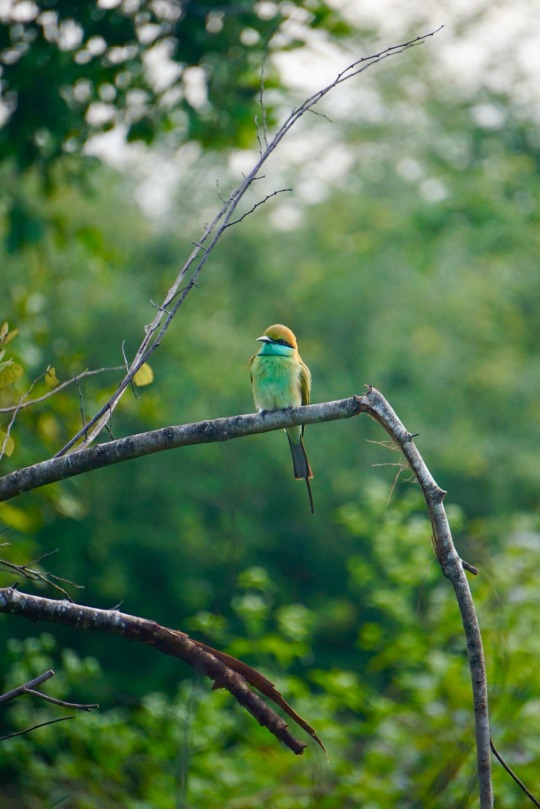
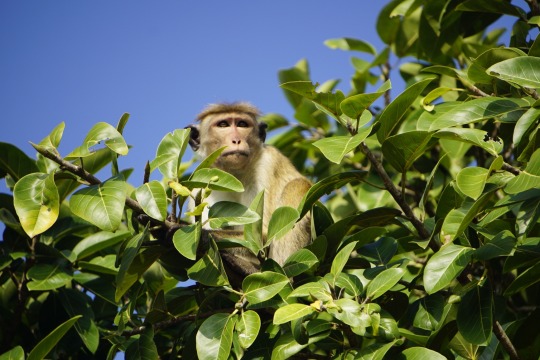


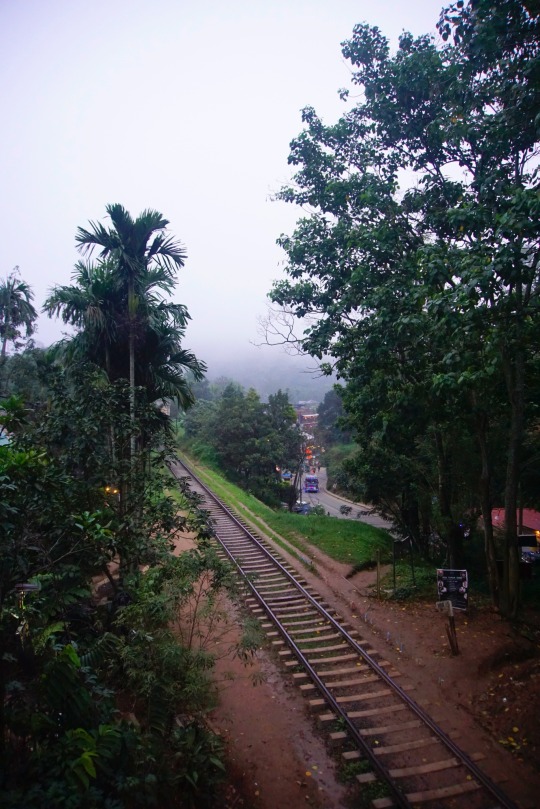
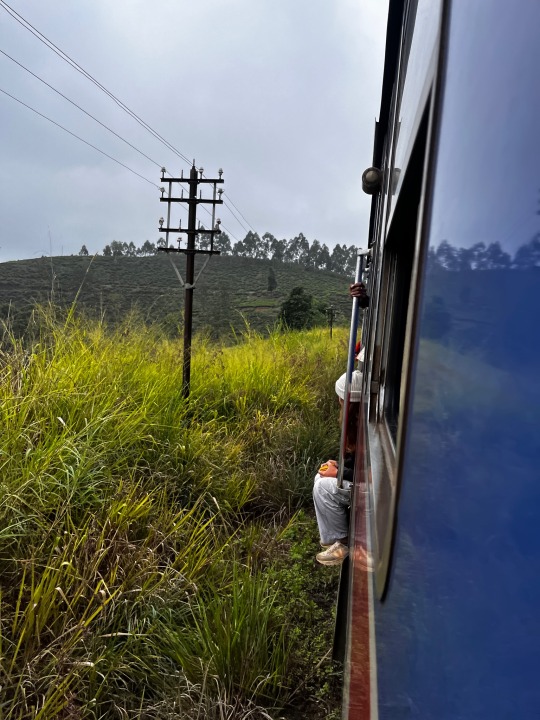

Sri Lanka part 2!
So despite getting sick on arrival, having a fucked up back and my period that never comes coming halfway through I managed to have the BEST TIME!
We moved in our solo traveller coalition from the southern beaches to Udawalawe National Park, where we met so many elephants and other animals. We got a lift in our safari jeep to the mountain town of Ella (and got stung by bees on the way there due to the very fast, windowless jeep driving through a SWARM of them)
Ella was a lot cooler as it was up in the cloud forests and there was a ton of tea plantations around which we visited, and got to pick a few tea leaves. From Ella, we got the very slow train to the city of Kandy through the hills which was magical. It was very, very long but just amazing. Food vendors got on at every stop, saying whatever they had in their baskets in a sing song voice as they moved through the packed train. At Kandy, we stayed for one night and visited the Temple of the Buddha’s Tooth for the evening ceremony and had such a curry and samosa feast afterwards ❣️ Then I said goodbye to my lovely group and made my way back to Colombo on the train. I left on a 2:45am flight via Dubai and now I am back home.
What a trip!!! I had no expectations and I was so wonderfully surprised. If you’re ever considering going one day do it!! I’m fuming to be back home.
20 notes
·
View notes
Note
What are monks and what do they do?
are they religious leaders like priest or are they schoolers or something else?
How did someone become a monk in ancient times? Was it a boys only position? Could just anybody become a monk or did you have to do something or be something to qualify?
By monk, I assume you mean "Buddhist monks"?
Well, they are members of the Sangha, one of the "Three Jewels" (三宝) of Buddhism, which consists of the Buddha, the Dharma (Buddhist Teachings), and the Monastic Community.
(Once again, I can only talk about Mahayana Buddhist monks in imperial China. If you want more info, I recommend talking to an actual Buddhist.)
Usually, when we say "monk" (僧/和尚), we don't just mean "adherents of the Buddhist religion", since you can offer incense at a temple, copy sutras, or have a statue of Bodhisattva Guan Yin on your private altar without becoming a monk.
These are people who 1) have gone through the relevant ordination rites and swear to abide by a set of religious vows, and 2) are part of a monastic community.
In other words, they are "cloistered" (出家人), leaving their home to learn and practice their religion in a temple, as opposed to lay practitioners (在家人) who carry out their religious activities in daily life.
And no, it's not a boy-only position——there are plenty of Buddhist nuns (比丘尼/尼姑) too.
Officially, to become a monk, you need to leave your worldly life behind. Which means, if your parents are still alive, you need to get their permission, if you are a court official, you need to quit your job, and if you are married, well, you cannot remain married.
Also, living in a monastic community means you were no longer considered viable for conscripted labor or taxation, and temples owned private lands, the increase of which could, well, depriving the imperial court of available land.
(This is one main motivation for historical prosecutions of Buddhism by certain emperors: the seizing of temple property + returning the monks and nuns back into the taxable population.)
As such, the imperial court tended to keep a firm control on the number of monks and the size of the temple. Basically, you need an official permit (度牒) from the state too, given out to each temple by the officials, and the monks didn't have the authority to make you one of their own in private.
Those who have committed one of the five grave crimes——killing their father, killing their mother, killing an arhat, destroying the unity of the monastic community, and "wounding the Buddha"——cannot become a monk either.
The most visible change one must make is shaving their head, like, entirely bald.
Those above the age of 7 but under 20 can become monks-in-training, called 沙弥/沙弥尼, but not formal member of the clergy because they are still considered too young to endure the physical and mental hardships.
(Similarly, adults who seek to become a formal monk must also pass through this training stage first.)
An aspiring monk, after receiving his permit, must first find a respectable monk, answer a series of questions that assess his fitness for monastic life, pay his respect to the Buddha and the monks of the temple he's joining, then becomes the disciple of one of those monks.
One monk will shave his head and bath him, while his master clothes him in his monk robes. Then, on the next day, he will receive his ordinations inside a temple hall, in front of the entire community, where he recites the monastic percepts (read: rules a monk must follow) and agrees to abide by them.
At this point, he has become a monk-in-training, which is a prerequiste stage for formal monk ordination, 比丘戒.
Usually, the latter ceremony is carried out at an actual altar, and the candidate must have already bought the "six necessasities" of monkhood ——three sets of robes, almsbowl, sitting cushion, and water container.
In Chinese Buddhism post-Yuan dynasty, the ordination rites may also include using burning incense sticks to leave a bunch of little marks (usually 12) onto one's head.
(Source: 《中国古代僧人生活》)
30 notes
·
View notes
Text
What are Nuns?
Nuns are a member of a religious community of women, especially a cloistered one, living under vows of poverty, chastity, and obedience.
They dedicate their lives to religious observance. Most nuns spend their time praying or meditating and doing service work in their communities.
Nuns in different religions 👇
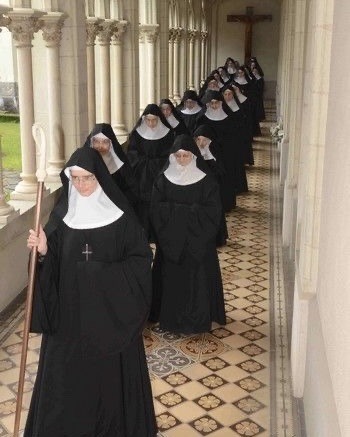
Nuns in Christianity.
Nuns and sisters in Christianity belong to various religious institutes, each with its own charism. Both take vows, pray, do religious services/contemplations & live modestly. Nuns traditionally recite the full Divine Office in church throughout the day, while lay sisters perform maintenance or errands outside the cloister. Externs, who live outside the enclosure, may also assist with tasks.
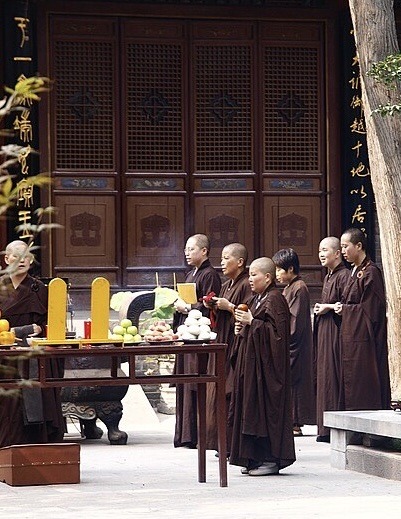
Nuns in Buddhism.
Buddhist nuns, called bhikkhunis, mostly live under disciplined & mindfulness. They share important vows, offer teachings on Buddhist scriptures, conduct ceremonies, teach meditation, offer counseling, & receive alms. Bhikkhunis are expected to go against the materialistic values, focusing instead on spiritual aims outlined by the Buddha. They adhere to specific precepts guiding their behavior/lifestyle, which vary based on tradition & monastery.
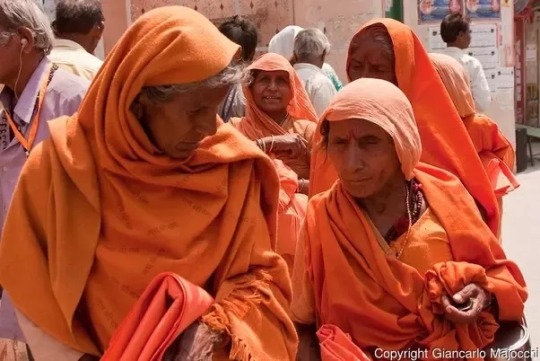
Nuns in Hinduism.
Hindu nuns, also called sanyasini, sadhavi or swamini, practice a monastic life of religious devotion by living simple lives of study, meditation & prayer. Some nuns seclude themselves in Hindu communities while others wander from place to place spreading the teachings of their faith, all their actions are directed as a service to Brahman. Hinduism teaches followers to respect these nuns for renouncing material things.
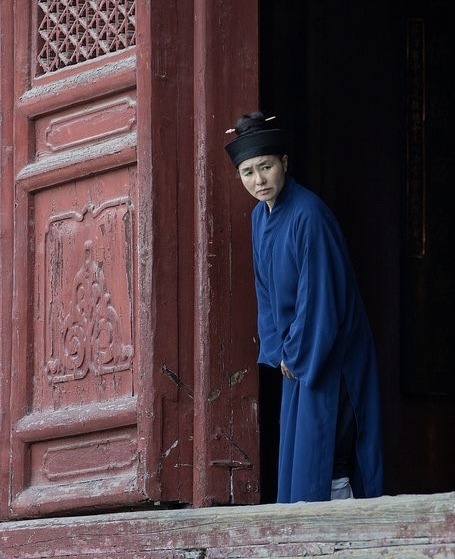
Nuns in Taoism.
Taoist nuns typically lived in temples known as guan, Celibacy was associated with early Taoist schools. They are solitary practitioners who take modesty & Clarity. In the Shangqing School, Taoist nuns are called nü daoshi or nüguan. their daily schedule included chanting scriptures, community work, and individual practices, including inner alchemical exercises.
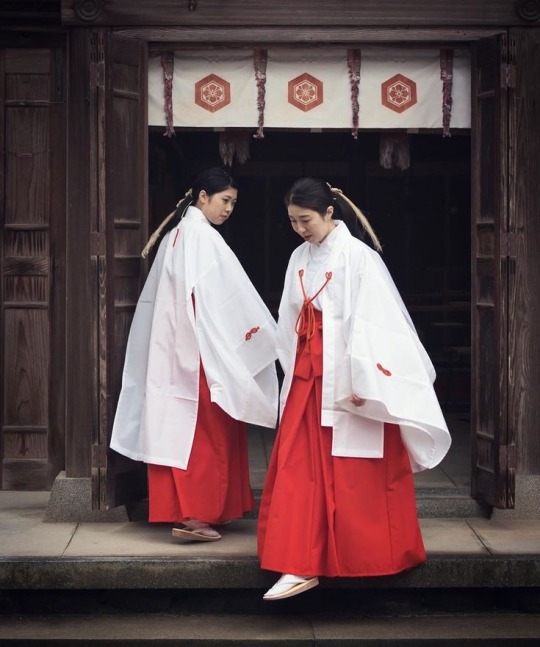
Nuns in Shintoism.
Shinto nuns are called miko, or shrine maiden, they’re young nuns who work at shrines & heavily worship Shinto Kami (gods). Miko were once likely seen as shamans & priestesses but they are understood in modern Japanese culture to have an institutionalized role in daily life, trained to perform tasks, ranging from sacred cleansing to performing the sacred Kagura dance.
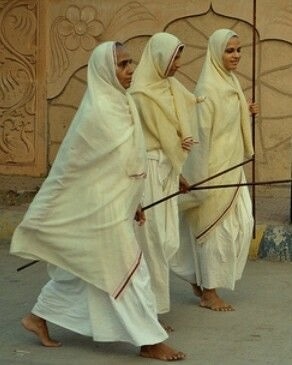
Nuns in Jainism.
Jain nuns are known as Aryika, or as Sadhvi. Aryikas (sadhvis) mostly meditate near Vrindavan, India. In Samavasarana of the Tirthankara, aryikas sit in the third hall. The Aryikas lead a simple life, with few possessions, and consider the world their family. They live in small groups and dedicate their days to meditation, study, carefulness & extreme compassion.
#religion#religions#nun#nuns#christianity#buddhism#hinduism#Taoism#Daoism#Shinto#shintoism#Jainism#bhikkhunis#bhikkhuni#sanyasini#sadhavi#swamini#nü daoshi#nüguan#miko#Aryika#desiblr#lotus-list
26 notes
·
View notes
Text
Yase Tenmangū Shrine 八瀬天満宮社
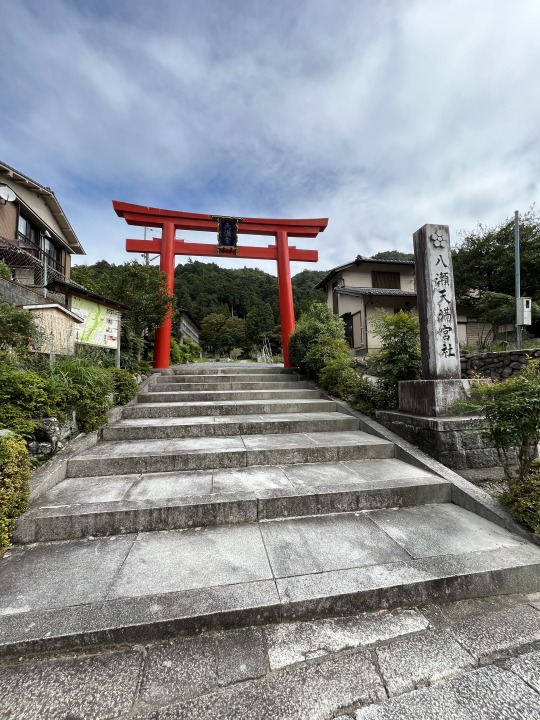
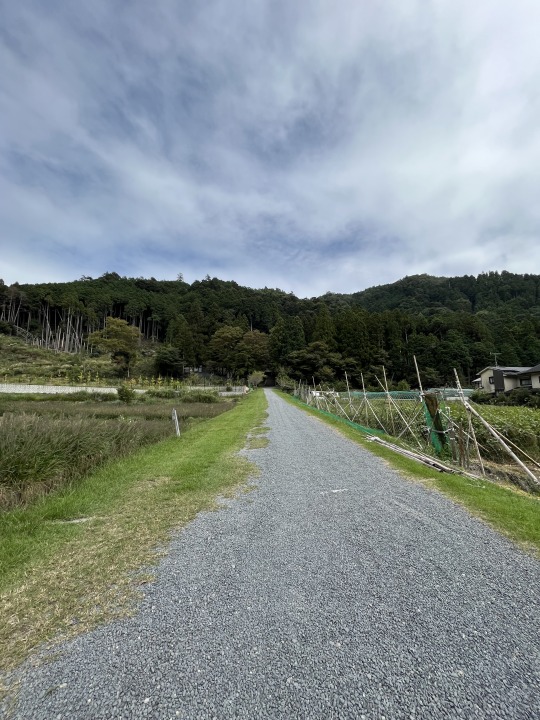
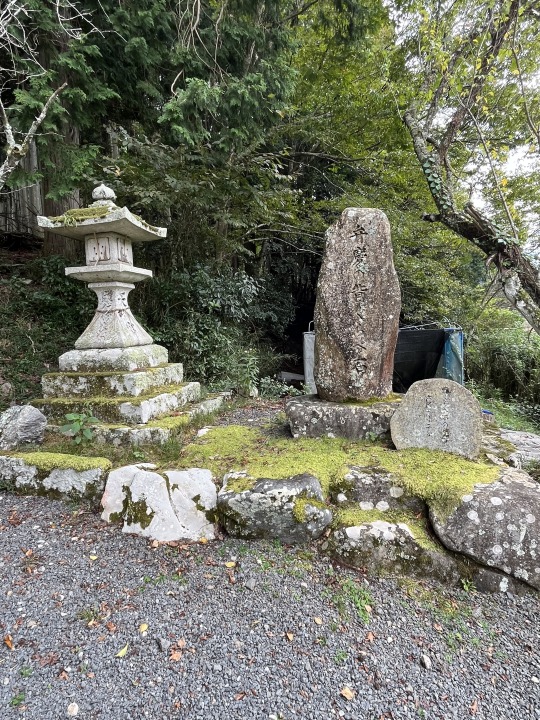
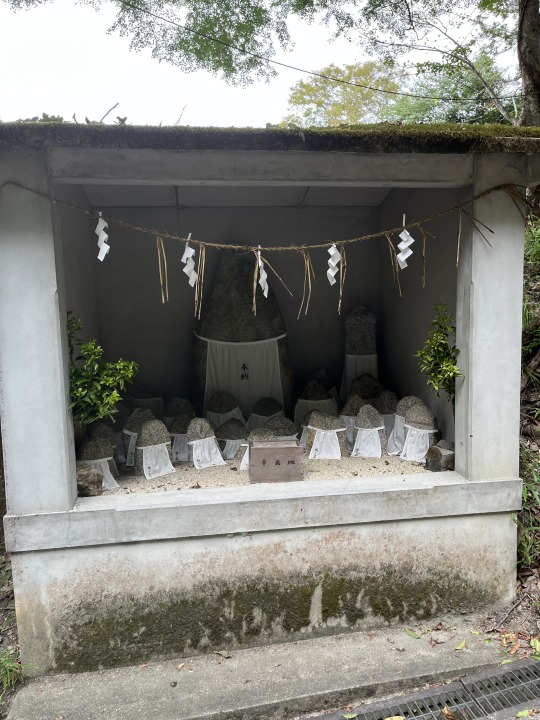
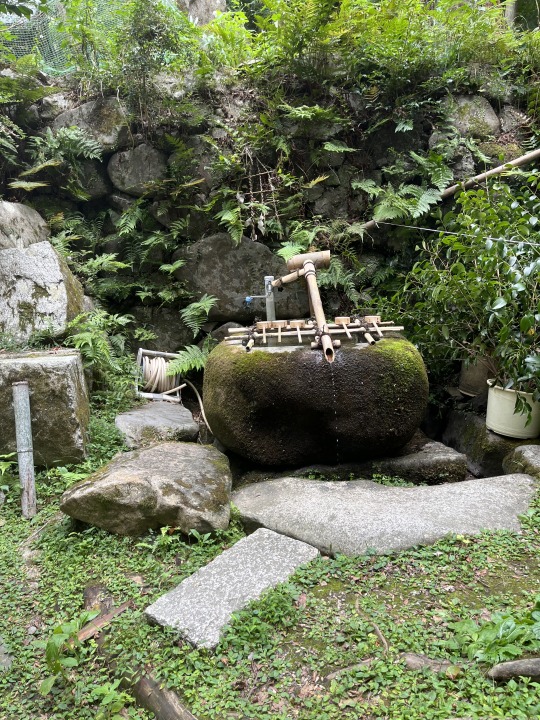
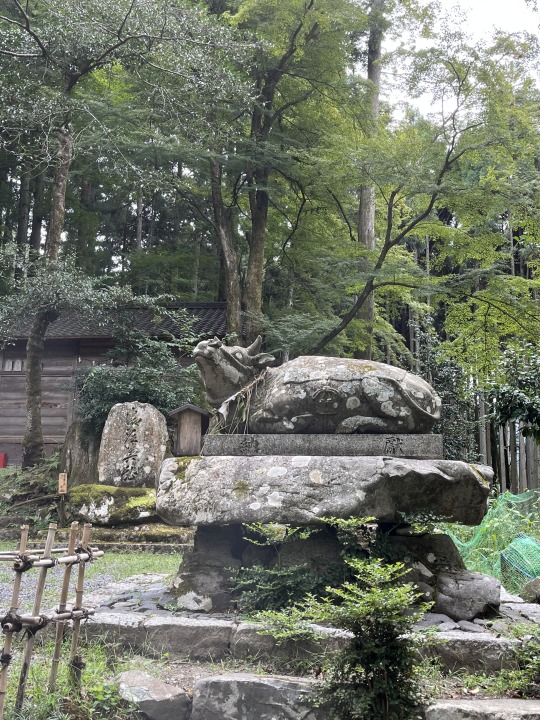
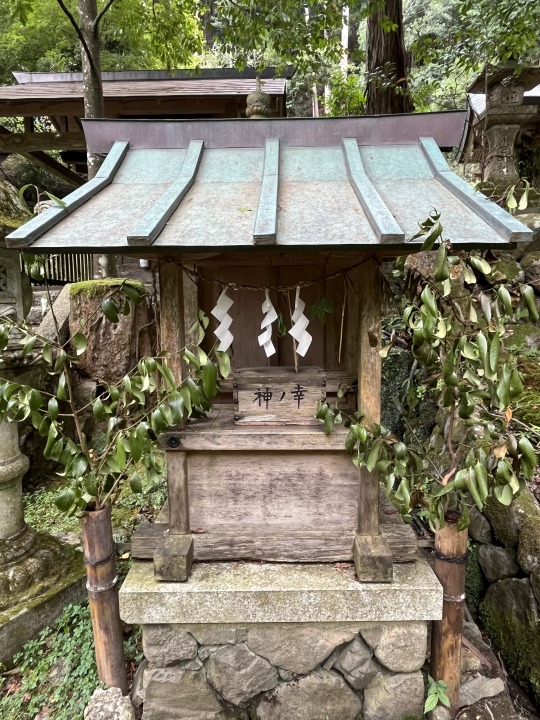
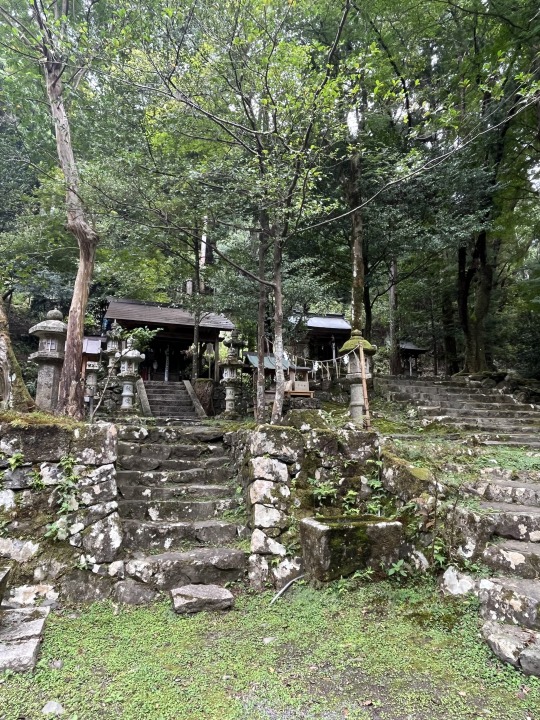
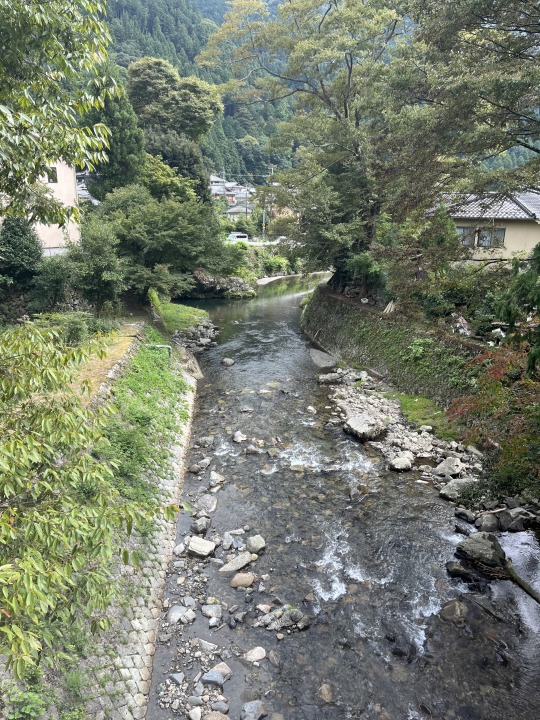

From the Plaque Explanation:
The deity enshrined here is Sugawara no Michizane (845-903)
The shrine is believed to have been established after Michizane's death, when his teacher of Buddhism Son'i (866-940) ceremonially transferred his spirit here. Inside the doors at the rear of the Main Hall is an image of the Eleven-Faced Kannon, which is considered the manifestation of Michizane as a Buddha.
When Michizane was young, he regularly visited Mt. Hiei to better himself and is said to have rested in this area. Until the Edo Period, it was called Yase Tenjingū. "Yase" literally means "arrow back," and during the 672 Jinshin Rebellion, Emperor Tenmu recovered from an arrow wound here. Thus, this area has very old connections with history.
The Tenmangū shrine has nine sub-shrines. The Akimoto Shrine on the south of the Main Hall enshrines Akimoto Tajima-no-Kami Takatomo, who was the shogunate elder counselor in charge of the lawsuit that settled the issue of Yase Village's exemption from taxation when there was a dispute with Mt. Hiei over the borders in 1710; he was enshrined in gratitude, and every year since, the Shamenchi Dance (Tax-Free Land Dance) is performed here.
On the slopes of the mountain behind the shrine is Goshodani (Palace Valley), where the temporary palace of Emperor Godaigo once stood when he was forced to flee to Mt. Hiei by Ashikaga Takauji. On the grounds are a number of other historical sites, including where Emperor Godaigo climbed Mt. Hiei, a monument to the village's restoration of tax-free status after the Meiji Restoration, a stone carved with a poem by the empress, the Compare Your Height with Benkei stone, and Michizane's seat.
The Tenmangū Shrine's annual festival is held on May 5th, the Akimoto Shrine's annual festival, the Shamenchi Dance (performed by the Yase Local Cultural Preservation Society) is held the night before Sports Day in October.
Enjoy!
9 notes
·
View notes
Text
Final Ceremony - Chapter 5
Characters: Esu, Kanna, Yume, Raika
Translator: Mika Enstars
Proofreader: 310mc
❗️ This chapter was voice-acted live at the 4piece Final Ceremony Live Event! You can listen as you read along!
"Ooh, that’s Kanna for you…! If there’s no god, then there’s no buddha either!"
[Read on my blog for the best viewing experience with Oi~ssu ♪]
Season: Summer
Location: Dance Room

And then, a few days later…
Esu: It’s I, the man appointed to be leader of Esupuri, Sagiri Esu… Stage name, Esu!!! Yup, exactly the same!
Although, well, I was only appointed because the original candidate for the leader declined and I was runner-up.
And today’s adventure is~? Dun-dundun-daah! ♪

Esu: A blood-drenched training session, in preparation for our upcoming debut live! First, we do our stretches!
Now let the adventure begin! Split your legs and lean forward! And forward! And forward! And forward!
Ow ow ow ow?! I can’t do this, any more and my groin will split in half! Is this a failed adventure~?
Yume: Good morning Esu. *squeeze* ☆
—Loud crack sound
Esu: AgyaaAAAAH?! I don’t think that crack sound was supposed to be heard coming from a human bodyyyYYY!?
Yume: Are you okay, Esu? Yume’s worried.
Esu: Since you think so, then how about you get off of meeEEE?! I’m gonna die at this rate! I’ll be folded in half!
Raika: Sagiri-sama… I mean, Esu-sama.
Uu. Nice-sama told us to call each other by our stage names, but a birdbrain like me’s havin’ trouble gettin’ used to it.
Um, so, Esu-sama… What should I be doin’ for this blood-drenched training session in preparation for our live?
I’ve largely sung on my own, so I don’t quite exactly know what to do…
Esu: (laying in agony)
Kanna: Esu-san does not appear to be capable of response at the moment, so allow me to respond to your questions in his place, Raika-san.
I believe the most important thing is to prioritize improvement of your singing and dancing, the primary objective of a live.
Here is the device that Nice-san has entrusted to us that contains the video of Esupuri’s debut song and its choreography.
I believe the first step for us all is to input this into our heads.
Also, please disregard what Esu-san said about a blood-soaked training session, as such a thing has no logical sense in terms of reaching our goal.
Fatigue and injury can potentially reduce concentration and precision.
Raika: Uh-hee… Thank you so much, Kanna-sama!
Kanna: Not at all.
Esu-san. I would not have stepped in if it had been a question from someone other than Raika-san, so please do not impose this position upon me in the future. It’s a hassle.

Esu: Ooh, that’s Kanna for you…! If there’s no god, then there’s no buddha either![1] Your stare is so cold that my heart could shatter to pieces!
Yume: Then you should only just look at Yume. So here, turn and look at Yume, okay?
Esu: Gyouh?! Can you consider the range of motion humanly possible for a neck?!
Raika: Eheehee~. ♪
Yume: ……
Raika-chan.
Raika: Yes? You need somethin’, Ohana-san? ♪
Yume: That is Yume’s line. You’ve been staring at Yume’s face. What is it?
Raika: Ahh, well ya told Esu-sama he “should only just look at Yume”, Ohana-san, and I thought it’d be a pleasure t’join in too!
Yume: Raika-chan.
Raika: Aye!

Yume: Get lost. Now.
Raika: Huuh?!
Yume: And don’t call Yume “Ohana-san”. Don’t speak at all. Don’t breathe, for that matter.
Raika: So cruel?! Why would you say that?!
Esu: Yume~. You can’t treat Raika-kun so poorly. We’ll be working together as a unit from here on, after all.
Yume: …Well, if Esu says so, then Yume will have to bear with it for now.
Esu: Now keep on bearing with it! Into the future! For the rest of your life!
Yume: ……
Isn’t old man Nice supposed to be coming today? He’s so irresponsible. Even though he said that he’d produce us and our unit.
Esu: Ah! Wow, you just changed the subject when you realized it wasn’t convenient for you, huh?
He was here earlier to set up this dance room. Prepped some songs and stuff for us.
But then he suddenly said, “I’ve got an idea for a nice promotion that’ll take the very world by surprise!”, and left the room with a skip in his step.
Kanna: “An idea for a nice promotion that’ll take the very world by surprise”?
I’m a tad curious what he means by that.
Within this industry, “producing” and “promotion” are defined as the use of various measures in order to increase the value of an objective.
For these methods, the monetary values and theories are generally already established.
However, judging from Nice-san’s behavior, perhaps he has come up with a different method.
If it is a new type of promotion that bases around the combination of subject and stimulus in order to draw in interest from others, then that is quite intriguing.

Raika: ♪~♪~♪~ (spinning in circles on his own, singing)
Yume: This isn’t a practice room. We are within a forest where fairies live. This speaker here is a house for a fairy. Fufu…♪
Kanna: ……
Esu: They both have lost interest..
I’ve told you that not everyone can keep up with your thought circuits! It’s rare for you to be so enthused though, Kanna~!

Esu: Well, point is, NiceP is doing a toooon of thinking for us, you know?
So what’s left for us to do is doing what we gotta!
How about we surprise NiceP by getting this done by the time he comes back? Results are not yet known! That’s what makes it an adventure!!!!
[ ☆ ]
← prev | story directory | next →
Esu makes a pun on Kanna’s name here; 神無 (Kanna) is the kanji for “god” (神) and “none” (無) together.
9 notes
·
View notes
Text
Villains Are Destined to Die calendar 2023


January: 1 - New Year's Day, 22 - Lunar New Year (there is a quote of Penelope at the end of the page)


February: 14 - Reynold's birthday (Reynold's quote)
March: 1- March 1st Movement, 31 - The day that Siyeon transmigrated into the game (Penelope's quote)


April: 1 - Siyeon's birthday, 5 - Sikmogil Arbor Day, 15 - the imperial ball (second prince's birthday, but who cares THIS IS THE FIRST MEETING OF PENELOPE AND CALLISTO AAAHHH) (Penelope's quote)
May: 5 - Children's Day, 6 - VADD Festival (I think it refers to the beginning of the festival), 27 - Buddha's Birthday (Derrick's quote)


June: 6 - Memorial Day / Hyeonchungil, 24 - a banquet hall commotion, 25 - the opening day of the hunting competition, 30 - Eckles' birthday
July: no VADD events or holidays (the two quotes are from Eckles)


August: 1 - Callisto's birthday <3, 15 - The National Liberation Day of Korea, 16 - Penelope's coming of age ceremony (I swear I thought it was a week after Callisto's birthday) (Callisto's quote <3)
September: 13 - Winter's birthday, 29 - Chuseok Festival (Winter's quote)
Since Tumblr limits the number of images in the post, I'll do a reblog with the remaining months, wait a little!
#villains are destined to die#death is the only ending for a villainess#death is the only ending for the villainess#death is the only ending for the villain#manhwa#vadd#ditoeftv
92 notes
·
View notes
Text

🌸Vlogs on Songkran🌸
While reading information about Songkran is useful, many Thai creators and vloggers walk us through Songkran in different parts of Thailand. Take a look at some of these videos to learn more!
What have we done in a provincial during Songkran? by ChawbanDoo
In this video, ChawbanDoo takes us through what he does in Singburi during Songkran. The vlog, which spans a few days, shows key components of Songkran, such as shopping and preparing for the holiday, bathing the Buddha image with nam ob, and water pouring with family members. Food is also central in this vlog: mu kratha and other dishes are shown. Finally, he pans to “playing Songkran,” which is him mostly watering his plants and then kids splashing cars with water.
Songkran Festival in Chiang Mai, Thailand by Thailand Travel
youtube
Thailand Travel’s video is on Songkran 2023 in Chiang Mai. As described, the video “highlights… the colorful parades, traditional ceremonies, and playful water fights. The parade of Buddha statues is one of the most important activities in the Songkran Festival in Chiang Mai. People believe that throwing water on Buddha statues or others will bring good luck to Buddha statues, others and themselves.”
ก็มาศิวัช EP.1 เมื่อศิวัชเล่นมุขเสี่ยวเที่ยวสงกรานต์ (Episode 1 Vlog) by Mark Siwat
youtube
Mark’s first vlog, Gor Ma Siwat, takes place on Songkran Day 2019. The day begins with the water pouring ceremony with his family. Afterwards, Mark shops for a Songkran outfit, looking through several floral and Hawaiian shirts and, as he stresses, a waterproof bag for personal items. Finally, the blog ends with some tips for the water gun fights (and other antics) at Siam Square’s Songkran Festival.
Battle Trip | 배틀트립 – Ep.93 Songkran Water Festival VS Thingyan Festival by KBS WORLD TV
youtube
In this 2018 episode of Battle Trip, one team of travelers attends Songkran and the other attends the Thingyan Festival to see which is the superior festival. In the first half of the video, the team travels to Chiang Mai to join the water fights there. Other important details are highlighted here, such as transportation during the holiday, smaller shops being closed, how to refill water guns, shopping at markets, street vendors, etc.
Tawan the Wanderer, EP. 6 by GMMTV
youtube
GMMTV’s series Tawan the Wanderer has a 2019 episode dedicated to Songkran. The video opens with some basic information about the Thai New Year before transitioning to Tawan going to markets to get flowers for the temple and celebrations. The video includes Tawan near Wat Phra Singh (a prominent temple), conversations with people in Chiang Mai about the festivities, and Tawan’s family as they cook food and spend time together.

🌸 What's SongkranFest2024? 🌸 Guidelines 🌸 Prompts 🌸 Discord & Carrd 🌸
31 notes
·
View notes
Text
Lingshan Hermit: Are You Relying on Vajradhara or Money-dhara?
In Tibet, every long-established Buddhist lineage has its own refuge field. The refuge field encompasses the images of all masters from the Dharmakaya Buddha to the Sambhogakaya Buddha to the human lineage holders, all the way to the most recent patriarch. On thangkas depicting the refuge field, you can see these lineage masters with calm gazes and elegant demeanors arranged according to their historical distance, appearing either far or near on the thangka. You can also see noble beings of both Mahayana and Hinayana traditions, as well as various deities and protectors. Some refuge fields have Guru Padmasambhava at the center, while others feature the deep blue Vajradhara. As lineage disciples, we prostrate to the refuge field, regarding them as our ultimate source of protection and support.
Although we prostrate to them daily, pray to them, and recite their prayers, do we truly believe in them? Do we truly believe they can protect us and solve all our problems? Do we truly believe they possess extraordinary powers? I have my doubts about this. From my observations, many people I've met haven't truly taken refuge in the Buddha, Guru Rinpoche, or Vimalamitra. Instead, they've taken refuge in dollars, power, and modern technology. Every day, they contemplate how to earn more money or which new Sichuan restaurant has opened, rather than how to attain enlightenment quickly. When they encounter problems, their first reaction is never to pray to their guru; instead, they think about checking Xiaohongshu (Red Book) for solutions or finding someone who can help. Perhaps only as a last resort would they think to seek help from their guru or the Three Jewels. This is their genuine and natural reaction, indicating what they truly believe in—money, power, and modern technology. So if they were honest with themselves, they should replace Guru Rinpoche at the center of their refuge field with dollars and a MacBook Pro, and replace Vajradhara with "Money-dhara."
Your behavior is an extension of your true values. Where you spend most of your time shows what you consider most important. Whom you first think to seek when you encounter problems indicates whom you consider most capable and reliable. And what you consider most important and powerful reveals your true values and merit. If you truly believe that those smiling buddhas, bodhisattvas, and lineage masters in the thangka are extraordinarily powerful, you would certainly think of them first when facing difficulties. If you don't believe they are powerful, don't believe they are the most powerful in the entire universe, don't believe they are incomparable, then the quality of your prayers and refuge is highly questionable.
But don't misunderstand me as criticizing this phenomenon. I have no such intention. Your perception is determined by your merit; what kind of perception you have depends on the abundance of your merit. Criticism cannot increase your merit, much less change your perception. Changing perception is a lengthy process. It requires long-term guru-disciple interaction and the confluence of various causes and conditions. I never fantasize that someone will immediately change their mind after reading my article. Between us lies a vast ocean of merit; for most people, even understanding is unlikely, let alone transformation.
Moreover, living in modern society, you must acknowledge the importance of money. If you want to attend an empowerment ceremony in Nepal, you need money for airfare and hotels. You need to pay monthly rent to your landlord, buy dresses, hairpins, toner, and electric toothbrushes for your girlfriend, give some to your parents, and make offerings. All these require money. Most people's merit is only sufficient to see the benefits money brings but not enough to see its harm. So don't pretend you don't love money; don't pretend money isn't important to you. Especially don't pretend you now love Guru Rinpoche and Yeshe Tsogyal more. If you believe money or power is more important, it's because your understanding of samsara is still superficial, your merit is still insufficient, you don't comprehend how powerful these lineage masters are, and you don't know that only they can truly help you. That's why you think this way. This is your authentic perception at this stage. You need not feel ashamed of this, nor should you pretend otherwise.
Only when you have accumulated sufficient merit, when your life experience is rich enough, when you begin to slowly understand samsara, when you begin to understand that everyone is suffering, that everyone is hiding their pain and pretending to be happy, that behind everyone's glamorous appearance are countless anxieties gnawing at them—only when you have seen enough people's lives, seen them build tall buildings, host grand banquets, seen their buildings collapse, seen their efforts to pursue happiness fail one by one, seen them ultimately gain nothing—will you develop greater trust and reliance on the noble beings in the refuge field. Only then will you know that money, power, or Novartis Pharmaceuticals cannot solve your problems; in fact, they only bring more problems. Most people who believe money can solve problems are those who don't have much money. So they mistakenly think these problems will disappear once they have money. But this is merely their wishful fantasy.
Written by Lingshan Hermit on September 26, 2024. First published on April 1, 2025.
Copyright Notice:All copyrights of Ling Shan Hermit's articles in Simplified and Traditional Chinese, English, and other languages belong to the natural person who owns "Ling Shan Hermit". Please respect copyright. Publishers, media, or individuals (including but not limited to internet media, websites, personal spaces, Weibo, WeChat public accounts, print media) must obtain authorization from Ling Shan Hermit before use. No modifications to the articles are allowed (including: author's name, title, main text content, and punctuation marks). We reserve all legal rights.
灵山居士:你依止的是金刚总持还是金钱总持
在西藏,每一个历史悠久的佛法传承都有自己的皈依境,皈依境囊括了从法身佛到报身佛到人间祖师一直到最近的那位祖师的形象。在绘有皈依境的唐卡上,你能看到这些眼神淡然举止优雅的传承祖师们按照年代的久远程度或远或近地逐一呈现在唐卡上,你还能看到大小乘的圣者,以及各种本尊和各种护法神。有些皈依境的中间是莲花生大士,有些则是深蓝色的金刚总持。作为传承弟子,我们会向皈依境做礼拜,以他们为我们最终的依止护佑处。
虽然我们每天都在礼拜他们,都在向他们祈祷,都在念诵他们的祈祷文,但我们真的相信他们吗?真的相信他们能保护我们能解决我们的所有问题吗?我们真的相信他们具有超强的能力?对此我很怀疑。我见过的很多人,从我对他们的观察来看,他们真正皈依的不是佛陀不是莲师、不是无垢友,他们皈依的是美元权力和现代科技产品,他们每天在琢磨的是怎么挣更多的钱哪里新开了个川菜馆而不是如何尽快成佛。假如他们遇到事情,他们的第一个反应也绝不是祈祷上师,他们想的是上小红书看看有没有解决办法,或是有没有认识的人可以帮助解决。可能到最后他们才会想到还可以向上师三宝求助。这是他们真实而自然的反应,这表示他们真正相信的是这些——是金钱权力和现代科技。所以如果他们对自己诚实的话,他们其实应该把皈依境中间的莲师换成美元和MacBook Pro,把金刚总持换成金钱总持。
你的行为是你真实价值观的延伸,你在什么地方花的时间最多,就表示你觉的什么东西最重要。你遇到事情第一个想到要找谁解决,表示在你的眼里这个人的能力最强最可靠。而你觉的最重要最厉害的东西,则展示了你真实的价值观和福德。如果你真觉得唐卡里那些微笑的佛菩萨祖师超级厉害,你遇到事情肯定会第一个想到他们。假如你不觉得他们很厉害,不觉得他们是全宇宙最厉害的,不觉得他们无与伦比,那么你的祈祷和皈依质量就非常堪忧。
但是不要误以为我是在批判这种现象。我完全没有这种意图。你的认知是由你的福德决定的,你有什么样的认知取决于你的福德多寡,而批判并不能使你的福德增长,更加不可能改变你的认知。改变认知是个漫长的过程。需要长期的师徒互动需要各种因缘具足才可能发生。我从来不幻想有人看了我的文章就能马上改变想���。我们之间隔着巨大的福德海,对大多数人而言,看懂都不太可能,更何况是改变。
而且生在现代社会,你必须承认金钱的重要性。如果你要去尼泊尔参加灌顶法会,你需要钱买机票住旅店,你要每月要缴钱给房东,要给女朋友买裙子发卡爽肤水和电动牙刷,要给父母一些,还要去做供养。这些都需要钱。大部分人的福德都只够让他们看到金钱所带来的好处而不够让他们看到它的坏处。所以不要假装自己不爱钱,不要假装钱对你不重要。更不要假装自己现在更爱莲师和依西措嘉。你认为钱或是权力更重要,那是因为你对轮回的认识还很粗浅,你的功德还很不够,你不了解这些传承祖师有多大能耐,也不知道真正能帮你的只有他们。所以你才会这么认为。这是你现阶段的真实认知。你完全无需为此惭愧。更加不必假装自己不是这样。
只有当你累积的功德足够多的时候,你的人生经验也足够丰富,你开始慢慢了解轮回,开始了解到每一个人都在受苦,了解到每一个人都在隐藏自己的痛苦假装快乐,了解每个人风光的背后都有无数的烦恼噬咬,只有在你看了足够多的人的人生,看到他们起高楼、看到他们宴宾客、看到他们楼塌了,看到他们追逐快乐的努力逐一失败,看到他们最终一无所获,你才会对皈依境里的圣众生起更大的信任和依止心,才会知道金钱、权力或是诺华制药解决不了你的问题,事实上它们只会带来更多的问题。大多数相信钱能解决问题的人都是没什么钱的人。所以他们误以为只要有钱这些问题就会消失。但这只是他们一厢情愿的幻想。
灵山居士写于2024年9月26日。首发于2025年4月0日。
3 notes
·
View notes
Text
trip updates part one: Tokyo
It was a mercifully smooth 12-hour flight from Minneapolis to Tokyo! The seat next to me was unoccupied, so I could stretch my legs out, sleep a bit, read, and watch my shows. I finished Black Friend by Ziwe, which I loved, and Alive: The Story of the Andes Survivors by Piers Paul Read. I also watched the first five episodes of Succession, season one! I'm so into this show.
It was so easy to navigate Tokyo via the subway. I took the train from the airport to my hotel, dropped my stuff off, and had time to visit Senso-ji Temple that evening. Visiting a religious site is something I like to do as soon after landing as possible. Senso-ji in the evening, lit up, was beautiful. I wandered through the temple grounds to look at the pagodas and the stone Buddha statues, while listening to the clinking of people dropping their coin offerings into the metal collection area. I found a little ramen spot nearby, and the ramen was incredible and very comforting after 12+ hours of travel, going through customs, navigating around a new city, etc.
The next day, I found a cute little cafe right next to my hotel where I could start my day with my caffeine fix. I headed to Tsukiji Market, and I LOVE a market. Normally I hate crowds, but when there's food involved, that hatred goes away. :) I explored the food stalls and ate all the seafood my little heart desired - crab legs, eel, scallops, a sashimi bowl.
I went to Meiji-Jingu shrine, in the middle of Yoyogi Park, which is very forested. One of the coolest things about this location was seeing a wedding ceremony that was taking place, with the couple and family dressed in traditional Japanese clothing. It was a lovely area to explore, and after I inevitably got lost in the park and found my way again, I had sakura flavored soft serve ice cream as a treat.
The Hamarikyu Gardens were an unexpected stop for me, while I waited for my evening kabuki show to start, and I'm so glad I went. The flower field there was yellow as far as my eyes could see, and there were tons of hummingbirds around.
The kabuki show was a cool experience - I loved the music, and the body language of the actors!
Other highlights of the rest of my time in Tokyo:
Matcha lattes and pancakes at the cafe near my hotel
Seeing cherry blossoms at Ueno Park!!
The collection of art and artifacts at Tokyo National Museum
The food - ramen, katsu curry, pho!
Soaking in the large, hot public bath at my hotel, which I had to myself that night.
One thing I didn't expect:
The weather! Coming from one of the coldest places in the United States, where it gets to be -30 F, I didn't think that Japan in spring would challenge me. And yet, it did. I brought my mid-weight spring coat, which has been working fine for me at home. For some reason, I found Tokyo very windy, and the wind cut right through me. I was very uncomfortable walking around, and finally, I had to buy another coat at Uniqlo here, as well as a scarf. I got both for ~$40 USD so it didn't break the bank, at least. :)
I got to Kyoto yesterday morning and I have more to journal about that, but I will do so in a separate post. :)
It has been amazing to be on vacation. To not have to worry about work, or grocery shopping, or cooking, or getting my workout done before work starts, or anything. I love my job and it still feels AMAZING to not work.
Oh, also, I almost forgot to add - I got an email as soon as I landed in Tokyo, confirming that I have been accepted at the university I applied for, and will be starting my MSW in fall. It's been a lovely celebratory trip!
24 notes
·
View notes
Note
What would it be like if there was a water festival (Songkran/Thingyan) in Valhalla? Which the reader (Replacement Fighter) and all the other gods, einherjars, valkyries, etc went to? Basically its a very well know festival commonly celebrated in South East Asia around April. With tons of food, drinks, celebrations, water fights, ceremonies, parties and performances to be enjoyed.
The water fights would involve people pouring/splashing water on each other with water guns, cups, buckets & water balloons. The parties usually consisted of popular songs, performances & dances which were either preformed by famous celebrities or volunteers, and even more water fights. There would also be additional events as the festival usually lasts between 3 to 5 days.


It's also common for a variety of vendors & booths to be involved during the celebrations. Especially the ones that sold food, beverages, snacks, trendy clothes to wear to the events, supplies to participate in the water festivals or souvenirs. Some people would also visit the temples during this time to either donate some money, flowers, lanterns, candles, etc or to just wind down from all the loud festivities.


Gods: Buddha, Rudra, Odin, Thor, Anubis, Apollo, Loki, Hades, Shiva, Poseidon & Susanoo
Humans: Sasaki, Lubu, Tesla & Leo
Ooh this looks so fun! I love the idea of having fun in summer like this and I love festival food :p that’s my favorite part of festivals and celebrations!
-Despite it literally being the land of the gods, which said gods control- Valhalla was dealing with a brutal heat wave, one that made everyone feel like they were melting.
-Training was banned to prevent heatstroke and other health related issues and anyone caught training was going to be punished.
-You had dealt with heat like this before, on earth, and you knew of the perfect solution to solve this! A water festival! Or at least a water party.
-You were pretty sure, based on how grumpy everyone was acting, that something the size of Songkran or Thingyan might be out of the question, at least as far as scale, but you could probably handle something about the size of your sanctuary.
-You got to work, sending out invites before preparing all sorts of food and treats, ice creams, fruit-based drinks, barbeque, you hung lanterns and decorations all around, and prepared your large pools, as well as smaller pools, water guns, and water balloons, perfect for a water party!
-On the day of the party your guests arrived, feeling miserable in the heat as you opened the door, revealing your oasis, which you had cooled using misters placed everywhere.
-Jaws dropped, seeing what you had done and while you weren’t smiling, your vibe was giving off smiling as you welcomed them in to enjoy your miniature water festival!
-Many went straight for the large pools, diving in, feeling the cool water which was a blessing in the heat while others went to the massive buffet you had prepared, seeing all the different drinks and foods to enjoy.
-Goll saw your kiddy pool full of water balloons and picked one up, “What is this Y/N?” you looked over and you nodded towards Loki, “Throw one at him.” Goll looked panicked while Loki looked almost offended, hearing you telling Goll to attack him, but she did as you told her, and he was drenched from the water balloon as soon as it hit him.
-Soon your sanctuary was filled with squeals and laughter as Loki was chasing Goll around, the two pelting each other with water balloons until they found the water guns, teaming up to sneak attack others which led to a bigger water fight.
-Everyone was laughing, having fun, enjoying themselves as you sat in the shade, eating a large slice of watermelon next to Lu Bu who was doing the same, staying out of the sun as you watched Brunnhilde powerbomb Zeus into a pool after he tried to touch her, leaving his body floating motionless in your pool.
-While the heat wave didn’t end for another few days, your water festival brought joy back to the citizens of Valhalla, even if just for a bit.
45 notes
·
View notes
Text
Info for writer in Thai series fandom: Holidays and Festivals
In my opinion, most holidays and festivals can be sorted by their relevance into a few categories, like the royal family, religion, or something inbetween. If its origin is something related to the royal family, it is likely that it will have fewer activities for people who are not government officers or students to do than when it relates to religion.
Piyamaharaj Day
Date : Oct 23
King Chulalongkorn (or Piyamaharaj) Day is to commemorate the day King Chulalongkorn passed away. King Chulalongkorn made many contributions in his reign, like the educational system, military affairs, national communication, the state railway, and the Slave Liberation Act without bloodshed in Thailand. Piya (ปิย) means beloved and Maharaj (มหาราช) means the Great King. As the name suggests, he was really popular. Many people have his picture in their house or their shop. He is also somewhat considered sacred, and some people will make a wish to him. The offerings that people believe he liked consist of brandy, cigars, shrimp paste rice, pink roses, and other general offerings.
Activities
The various departments will send their representatives to lay wreaths of flowers to pay homage at his statue and make merit in His Majesty King Chulalongkorn's name. People who loved him will do that too. Many government agencies, schools, and universities will also hold exhibitions to educate the public about his life and work.
The current queen’s birthday Date : Jun 3
The current king’s birthday Date : July 28
Activities Most government agencies and schools will set up the king or queen's picture, decorate it, and arrange a place for people to sign their name to wish them a happy birthday. They might also hold exhibitions about their lives and the work they do for the public too. I'm glad I didn't have to do it anymore. It's really hard to make an informative board when there is so little information in the first place.
Coronation Day
Date : May 4
In Thailand, we call it Chat-Mong-Khon day. Chat (ฉัตร) means several-tiered umbrella. In this case, it is nine-tiered, symbolizing the sovereign. Its Thai name refers to the ceremony they do on the date that the coronation of the current king happens. Originally, this ceremony was considered a private ceremony of the King, held in the royal court, but later it became a national holiday.
Activities
There are none, but like every special day and occasion in Thailand, it was encouraged to make merit on this day.
The Royal Ploughing Ceremony
Date : May, at the beginning of the month, depends on what day is the most auspicious according to astrology.
The main purpose of the ceremony is to boost the morale of farmers across the nation. The highlight is the sacred bull's choice, which will predict the amount of rain and which product will flourish, and the rice sowing, which won't really have a chance to grow because the audience will collect it up immediately as it is believed to bring luck and help the crop grow when they mix the seed in. After the ceremony, the model farmer usually received a plaque of honor from the king or representative.
Activities
Other than in the ceremony, there are none.
Magha Puja
Date: The 15th day of the waxing moon (full moon) of the 3rd month according to the Thai lunar calendar.
A day celebrates a gathering that was held between the Buddha and 1,250 of his disciples who came to see the Buddha without being summoned. From the tale, all of them are already Buddhist saints (Arhat) and all of them are direct disciples ordained by the Buddha himself.
Activities
Go to the temple, abstaining from all sins, offer alms or make merit by giving freedom to animals (release birds or fish) that got caught-about this one, I must say that it's a thing you shouldn't do on a whim. Too many people do it without any consideration for the environment or even whether the animals they release will survive. They do it just because it's a "tradition". Their actions also create demand for birds or fish that wouldn't get caught otherwise. It's more sin than merit at this point. Listen to a sermon and go wian tian (เวียนเทียน) which is to walk with lighted candles in hand around a temple in the evening.
Visakha Bucha, or Vesak
Date: The 15th day of the waxing moon of the 6th lunar month or, in other words, the full moon day of the Visakha (visakha is the name of the month in the lunar calendar).
It is a day that marks the three most important events in Buddhism, namely the birth, enlightenment, and death of Gautama Buddha, with all three events taking place on the same day but in different years according to Thai interpret.
Activities
The same thing you do on Magha Puja.
Asanha Bucha
Date: The full moon day of the 8th month of the lunar calendar.
It is the day that Gautama Buddha gave his first sermon, the Dhammacakkappavattana Sutra, to Kondanna, Bhaddiya, Vappa, Mahanama, and Assaji. The day after Asanha Bucha will be the day Buddhist Lent starts.
Buddhist Lent or, in Thai, Khao Phansa.
"Khao Phansa" means "Rains Retreat", which means all monks must stay at any temple during the rainy season. Because the monks in Buddha's time had a duty to make pilgrimages to animals and spread the Dharma and teachings to the people in various places. There is no need to have a fixed place to live, even in the rainy season. The villagers blamed them for stepping on the seedlings and other crops until they were damaged. Therefore, the Buddha laid down a Buddhist Lent regulation for the monks to stay stationary for three months in the rainy season.
Activities
Because Asanha Bucha and Khao Phansa are next to each other, sometimes the activities get mixed up. For Asanha Bucha, we do the same thing we do on Magha Puja and Visakha Bucha days. Khao Phansa will have more occasional things happen, but like I say, it can get mixed. One day is not a big deal at all. There will be a Buddhist ceremony, as well as preparations for the monks' and novices' residence to be in good enough condition to be used for three months during Buddhist Lent. There will also be a Candlelight Procession (Phi-Tee-Hae-Tian-Phan-Sa:) in which we will take special candles (one of the popular activities is to cast that candles by providing materials such as wax, candle wicks, crucibles, and pans for the crowd to use to make them together in a public place such as in front of the mall), we make before Khao Phansa Day, go to the monastery to present the candle to the monk, then put candles into the temple, and light candles to worship the Three Jewels. There are also other activities, such as offering clothes to the monk, praying that they will conduct themselves within the framework of the Five or Eight Precepts, listening to sermons, and the Dharma. You can choose to participate as much or as little as you want. It is up to your faith and abilities. For monks, there will be a lot of other activities, but for ordinary people, I think this will be all. At the end of Buddhist Lent there will be Tak Bat Devo festival.
The Vegetarian Festival, or Tesakan Gin Jay (เทศกาลกินเจ)
Date: Start on 1st day of the 9th lunar month according to the Chinese calendar and last 9 days.
It is came from Taoist tradition. During the fastival people who choose to paticipate will only eat food that prepared without meat or products of animal origin (e.g. milk, eggs, honey, fish sauce, gelatin, collagen) and not flavored with strong smell vegetables such as garlic, onions, spring onions, shallots, chives, and cilantro, some also Including hot and spicy spices.
Moon Festival
Date: The full moon day of the 8th month according to the lunar calendar.
It is a traditional Chinese cultural festival that takes place in the middle of autumn to celebrate the harvest. Some households will celebrate it with their family, some don't. The ceremony will be held in private, so I'm not sure how popular it actually is, but the mooncakes sure are.
Chinese New Year
Date: The 1st day of the 1st month in the Chinese calendar.
Thais of Chinese descent will follow the tradition for 3 days: pay day (wan jai/วันจ่าย), pay respect day (wan wai/วันไหว้) and travel day (wan tiao/วันเที่ยว).
Pay Day is the day before the end of the year. It is a day when we have to buy food, fruits, and various offerings before the shops close for a long vacation.
On Worship Day, the day starts in the early morning by paying homage to "Bài lǎoyé" (拜老爺 / 拜老爷) which is a form of worship to various gods. The offering is three meats (Sasae, Sam Cheng), pork, duck, and chicken, and liquor, tea, and paper money. After that, we pay respect to "Pai Pae Bo" (拜父母), which is to pay respect to ancestors, parents, relatives, and relatives who have passed away. This will be completed no later than noon. The offerings consisted of sa sae, sweet and savory dishes (mostly done as the deceased once liked), as well as the burning of paper money, gold paper, and paper clothes to dedicate to the deceased. Then the whole family will be gathered to eat and exchange red packets afterward. Finally, we will pay homage to "Pai Ho Hia Tee" (拜好兄弟), which is respect for the spirits of the deceased brothers and sisters. The offerings will be kanom keng, kanom tian, taro in syrup, silver and gold paper, along with firecrackers to ward off evil and for good luck.
The day of travel or holding day is the new year's day. It is the first day of the first month of the year. Today, it is a tradition called "Pai Jia," which is an occasion to go to another's house to wish them luck and ask for blessings from the elders and loved ones.
Qingming
Date: 15 days after the spring equinox.
It is believed that Qing Ming Day is one of the three days when the human world and the spirit world are closest to each other. So during this period, it is a custom to go sweeping and pay respect to ancestors' tombs. Moreover, during Qingming, the weather is good. Therefore, it is suitable for the descendants to travel to the graves of their ancestors to pay homage, sweep and clean around the graves of their ancestors.
( He is coming to me's Thai name is He came to Qingming next to my grave.)
Songkran or Thai New Year
Date: 13 April
The word "Songkran" comes from Sanskrit and means "moving." It refers to how the zodiac sign is moving, which means the new year. Songkran is a traditional family practice where water is the main element of the ceremony. Basically, there will be 1.Bathing Buddha images at home and at temples for good fortune and making merit, offering food to monks ***By bathing, I mean gently pouring water from a water bowl (ขันน้ำ) onto the Buddha images. 2.Gently pouring water from a water bowl onto each other and wish each other luck in the new year. It will be more formal when it's between an elder and a child than between friends. 3. Ask for forgiveness for something that has already passed or a New Year's wish from an elderly person. 4.Loading sand into the temple. It is believed that it will bring auspiciousness, happiness, prosperity, and a lot of money, like the grains of sand that are carried into the temple. Another belief is that taking the sand that is attached to the feet from the temple is a sin. Therefore, to not commit a sin, we should bring it back to make up for what we take during the past year. It is mainly a family event, so it is also a time when most people travel back home to their family. Many people work far from home and don't have many chances to go back, so in the Songkran period they will go back and have a family gathering.
The water fight is not really traditional, but it's a main event that has many people waiting eagerly now.
Loy Krathong Festival
Date: The 15th waxing moon of the 12th month according to the Thai lunar calendar.
Loy means float, and Krathong, in this context, means banana leaf vessel or floating basket. The traditions vary by region, but one thing they all have in common is that it takes place at night and includes float Krathong. The purpose of this event is to either worship the goddess of water, Ganga, pronounced in Thai as "Khong-ka", or to worship the Buddha, or both. The krathong that is used in this event can be made from a lot of things, such as banana leaf, banana stalk pith, foam, coconut shell, or bread. There are many beliefs around this event. For lovers, sometimes the pair will use one Krathong together or go float it together and try to make it stick together after it goes into the water, as it is believed to be a good sign for a pair of lovers. During fastival, the atmosphere can be quite romantic. There is also a belief that you can float away all suffering along with the krathong by cutting nails, hair, and money and putting them into the krathong before floating it.
Yi Peng Festival
Date: the 13th to the 15th waxing moon of the 12th month according to the Thai lunar calendar or the 15th waxing moon of the 2nd month according to the Thai Lanna lunar calendar. On the same day as the Loy Krathong Festival.
Yi Peng is actually a variation of Loy Krathong, but instead of only Krathong, it will also have Khomloy, which is some kind of hot-air balloon, and it will actually happen two days before. The Yi Peng starts on the 13th day of the waxing moon, which is considered "Wan-da(วันดา)" or the day of the preparation to make merit at the temple. When it comes to the 14th day of the waxing moon, Father Oui (grandpa/elderly man), Mae Oui (grandma/elderly woman), and those who have faith will go together and conduct themselves within the precepts, listen to the Dharma, and make merit at the temple. A large krathong will be made in the temple courtyard. Inside the krathong will be food and other consumables. Anyone can bring something to make a contribution. Those items will be given to the poor to make merit. On the 15th day of the waxing moon, the big Krathong at the temple and the small personal Krathong will be floated on the river.
Index
78 notes
·
View notes